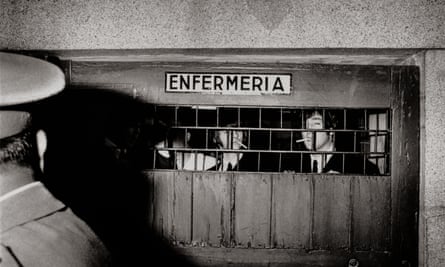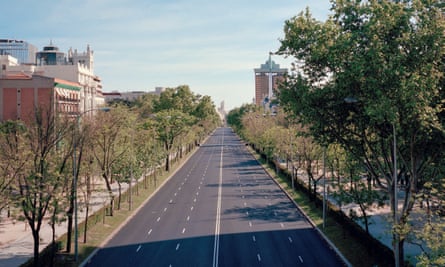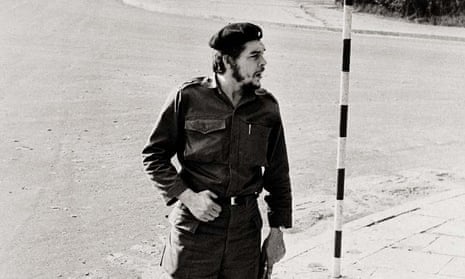One warm June weekend 61 years ago, a scruffily bearded Argentinian on his way from Cuba to Cairo stopped over in Madrid. With almost a day to kill between flights, he did what any tourist of the time would have done: explored the city, visited a bullring, had breakfast and did a little shopping.
He was, however, no ordinary tourist. A photograph taken very early that Sunday morning shows the unmistakable figure of Che Guevara standing in boots, beret and battle fatigues, one hand hooked over his belt and the other clutching a newspaper.
The image, shot by a teenage photographer, is one of 160 pictures in a book chronicling the Spanish capital’s richly turbulent social, political and cultural history from 1900 to the present day.

In its glossy pages, a Zeppelin flies over Gran Vía in 1930 – presaging the German and Italian warplanes that would darken Madrid’s skies later the same decade; the Beatles take a cigarette break before a concert at Las Ventas bullring; seven models sprint through the mushrooming suburbs of the 1970s, and the capital parties through the post-dictatorship cultural boom known as La Movida madrileña.
Intended as a family photo album for an entire city, the book – called simply Madrid – features images taken by some of the most famous Spanish and foreign photographers of the past century, among them Alfonso, Joana Biarnés, Robert Capa, Henri Cartier-Bresson, Alberto García-Alix, Cristina García Rodero, Ramón Masats and Gerda Taro.
As the writer Antonio Muñoz Molina points out in the book’s prologue, “many voices and many eyes are needed to tell the story of a city over time, a simultaneous yet successive Madrid, forever trapped in the same noisy racket, in a conflictive, needy state that endures despite the changing times and fashions, inhabited by people who embrace tragedy and merriment with equal fervour, alway beleaguered by the quest for food and festivity”.
One of the city’s rare moments of silence comes in the book’s potent final photograph, in which the normally heaving Paseo de la Castellana lies utterly deserted during the Covid-19 lockdown earlier this year.
The enforced confinement of the spring and early summer allowed the project’s editors, César Martínez-Useros and Miriam Querol, to whittle down the 2,500 pictures they had drawn from a variety of archives.
“It was a fun way to spend the lockdown but, at the same time, it was really difficult because we couldn’t be sitting working at the same table,” says Martínez-Useros, the editorial director of La Fábrica publishing house, which produced the book with support from Madrid city council.
While the capital is not exactly under-photographed, La Fábrica felt it had never got the photographic biography it deserved.
“There are a lot of photo books about picturesque Madrid, or secret Madrid, but there wasn’t a book that showed the Madrid that the great masters of photography had shot,” says Martínez-Useros.

“The idea wasn’t to show a picture-postcard, beautiful Madrid, but to show it as Spanish and international photographers saw it.”
Their lenses offer a moving and often mischievous view of the city – and one that questions some of the old cliches. One of Martínez-Useros’s favourite pictures shows two bullfighters posing coquettishly behind fans in 1967 – “we’re back in some of the hardest days of the Franco era, but here we have two toreros camping it up”.
As the editor notes, the fact that so few interior shots are included in the book is testament to madrileños’ love of streetlife.
“You see a lot of different social classes in the book, and, as in life, they’re intermingled,” he says. “Madrid isn’t a city like Paris or London, where the separation of classes is very marked. It’s mixed like all cities are, but all those points of view converge on the streets. The streets are the common area and one that belongs to everyone.”
The veteran photographer César Lucas has four photographs in the book.
Although Lucas has photographed everyone from Buster Keaton to Sean Connery, Brigitte Bardot and John Lennon, his shot of Che Guevara – which only found a wider audience following an exhibition in the 1980s – remains among his best known works.
Now 79, Lucas had turned 18 a few days before a colleague called and asked if he’d like to help cover Guevara’s brief stopover in June 1959.
“To tell the truth, I didn’t know very much about Che Guevara then so when I heard he was coming, I looked through the papers to see how I should act around him but it wasn’t like nowadays – there was no Wikipedia,” he says.
“I didn’t speak to him a lot because I wouldn’t have known what to say to him. Shit, I was just 18. I could never have imagined what he’d go on to become, or that the picture I took that day would become part of history.”
